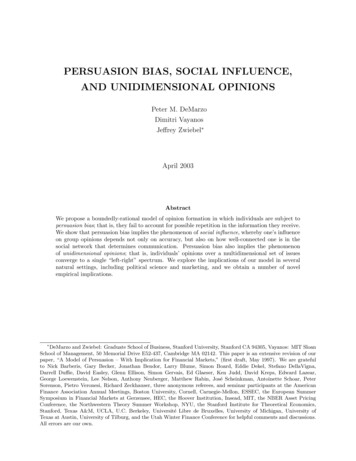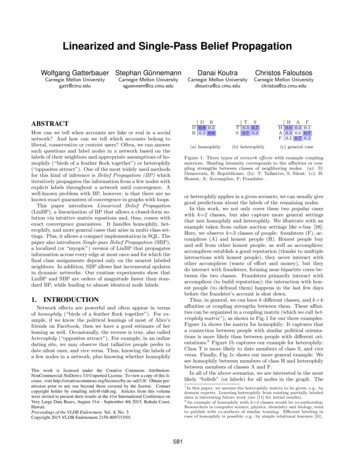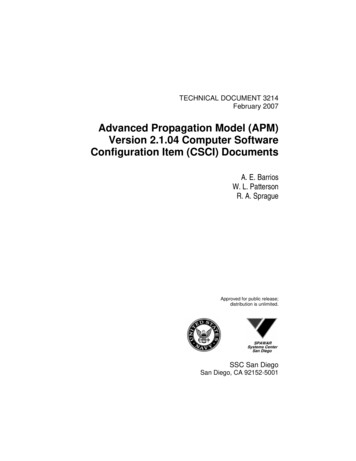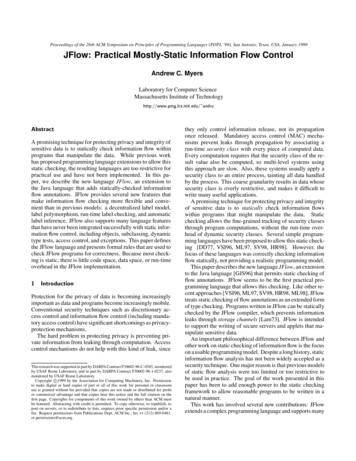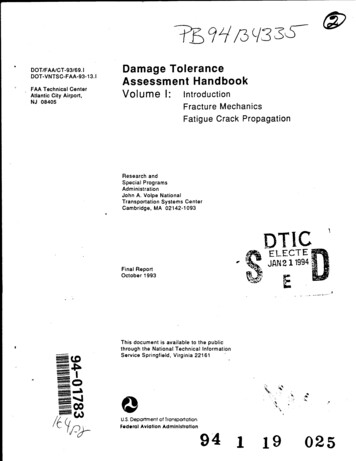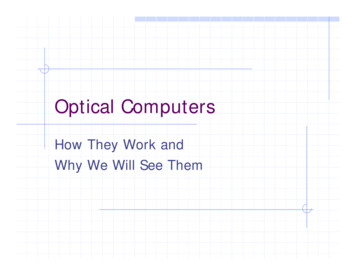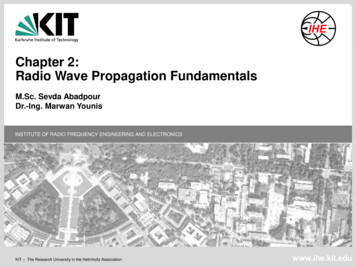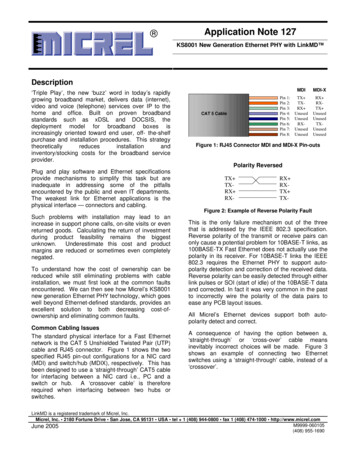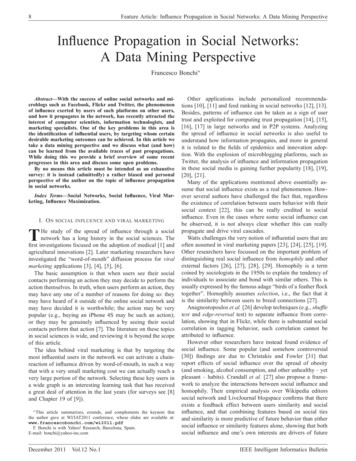
Transcription
8Feature Article: Influence Propagation in Social Networks: A Data Mining PerspectiveInfluence Propagation in Social Networks:A Data Mining PerspectiveFrancesco Bonchi Abstract—With the success of online social networks and microblogs such as Facebook, Flickr and Twitter, the phenomenonof influence exerted by users of such platforms on other users,and how it propagates in the network, has recently attracted theinterest of computer scientists, information technologists, andmarketing specialists. One of the key problems in this area isthe identification of influential users, by targeting whom certaindesirable marketing outcomes can be achieved. In this article wetake a data mining perspective and we discuss what (and how)can be learned from the available traces of past propagations.While doing this we provide a brief overview of some recentprogresses in this area and discuss some open problems.By no means this article must be intended as an exhaustivesurvey: it is instead (admittedly) a rather biased and personalperspective of the author on the topic of influence propagationin social networks.Index Terms—Social Networks, Social Influence, Viral Marketing, Influence Maximization.I. O NSOCIAL INFLUENCE AND VIRAL MARKETINGHe study of the spread of influence through a socialnetwork has a long history in the social sciences. Thefirst investigations focused on the adoption of medical [1] andagricultural innovations [2]. Later marketing researchers haveinvestigated the “word-of-mouth” diffusion process for viralmarketing applications [3], [4], [5], [6].The basic assumption is that when users see their socialcontacts performing an action they may decide to perform theaction themselves. In truth, when users perform an action, theymay have any one of a number of reasons for doing so: theymay have heard of it outside of the online social network andmay have decided it is worthwhile; the action may be verypopular (e.g., buying an iPhone 4S may be such an action);or they may be genuinely influenced by seeing their socialcontacts perform that action [7]. The literature on these topicsin social sciences is wide, and reviewing it is beyond the scopeof this article.The idea behind viral marketing is that by targeting themost influential users in the network we can activate a chainreaction of influence driven by word-of-mouth, in such a waythat with a very small marketing cost we can actually reach avery large portion of the network. Selecting these key users ina wide graph is an interesting learning task that has receiveda great deal of attention in the last years (for surveys see [8]and Chapter 19 of [9]).T This article summarizes, extends, and complements the keynote thatthe author gave at WI/IAT2011 conference, whose slides are available at:www.francescobonchi.com/wi2011.pdfF. Bonchi is with Yahoo! Research, Barcelona, Spain.E-mail: bonchi@yahoo-inc.comDecember 2011Vol.12 No.1Other applications include personalized recommendations [10], [11] and feed ranking in social networks [12], [13].Besides, patterns of influence can be taken as a sign of usertrust and exploited for computing trust propagation [14], [15],[16], [17] in large networks and in P2P systems. Analyzingthe spread of influence in social networks is also useful tounderstand how information propagates, and more in generalit is related to the fields of epidemics and innovation adoption. With the explosion of microblogging platforms, such asTwitter, the analysis of influence and information propagationin these social media is gaining further popularity [18], [19],[20], [21].Many of the applications mentioned above essentially assume that social influence exists as a real phenomenon. However several authors have challenged the fact that, regardlessthe existence of correlation between users behavior with theirsocial context [22], this can be really credited to socialinfluence. Even in the cases where some social influence canbe observed, it is not always clear whether this can reallypropagate and drive viral cascades.Watts challenges the very notion of influential users that areoften assumed in viral marketing papers [23], [24], [25], [19].Other researchers have focussed on the important problem ofdistinguishing real social influence from homophily and otherexternal factors [26], [27], [28], [29]. Homophily is a termcoined by sociologists in the 1950s to explain the tendency ofindividuals to associate and bond with similar others. This isusually expressed by the famous adage “birds of a feather flocktogether”. Homophily assumes selection, i.e., the fact that itis the similarity between users to breed connections [27].Anagnostopoulos et al. [26] develop techniques (e.g., shuffletest and edge-reversal test) to separate influence from correlation, showing that in Flickr, while there is substantial socialcorrelation in tagging behavior, such correlation cannot beattributed to influence.However other researchers have instead found evidence ofsocial influence. Some popular (and somehow controversial[30]) findings are due to Christakis and Fowler [31] thatreport effects of social influence over the spread of obesity(and smoking, alcohol consumption, and other unhealthy – yetpleasant – habits). Crandall et al. [27] also propose a framework to analyze the interactions between social influence andhomophily. Their empirical analysis over Wikipedia editorssocial network and LiveJournal blogspace confirms that thereexists a feedback effect between users similarity and socialinfluence, and that combining features based on social tiesand similarity is more predictive of future behavior than eithersocial influence or similarity features alone, showing that bothsocial influence and one’s own interests are drivers of futureIEEE Intelligent Informatics Bulletin
Feature Article: Francesco Bonchibehavior and that they operate in relatively independent ways.Cha et al. [32] present a data analysis of how picturepopularity is distributed across the Flickr social network, andcharacterize the role played by social links in informationpropagation. Their analysis provides empirical evidence thatthe social links are the dominant method of informationpropagation, accounting for more than 50% of the spread offavorite-marked pictures. Moreover, they show that information spreading is limited to individuals who are within closeproximity of the uploaders, and that spreading takes a longtime at each hop, oppositely to the common expectations aboutthe quick and wide spread of word-of-mouth effect.Leskovec et al. show patterns of influence by studyingperson-to-person recommendation for purchasing books andvideos, finding conditions under which such recommendationsare successful [33], [34]. Hill et al. [35], analyze the adoptionof a new telecommunications service and show that it is possible to predict with a certain confidence whether customerswill sign up for a new calling plan once one of their phonecontacts does the same.These are just few examples among many studies reportingsome evidence of social influence. In this article we donot aim at providing an exhaustive survey, nor we dareentering the debate on the existence of social influence atthe philosophical/sociological level. We do not even discussfurther how to distinguish between social influence, homophilyand other factors, although we agree that it is an interestingresearch problem. Instead, we prefer to take an algorithmic anddata mining perspective, focussing on available data and ondeveloping learning frameworks for social influence analysis.Once sociologists had to infer and reconstruct social networks by tracking people relations in the real world. This isobviously a challenging and costly task, even to produce moderately sized social networks. Fortunately nowadays, thanks tothe success of online social networks, we can collect very largegraphs of explicitly declared social relations. Moreover, andmaybe more importantly, we can collect information about theusers of these online social networks performing some actions(e.g., post messages, pictures, or videos, buy, comment, link,rate, share, like, retweet) and the time at which such actionsare performed. Therefore we can track real propagations insocial networks. If we observe in the data user v performingan action a at time t, and user u, which is a “friend” of v,performing the same action shortly after, say at time t Δ,then we can think that action a propagated from v to u. If weobserve this happening frequently enough, for many differentactions, then we can safely conclude that user v is indeedexerting some influence on u.In the rest of this article we will focus on this kind ofdata, i.e., a database of past propagations in a social network.We will emphasize that when analyzing social influence, it isimportant to consider this data and not only the structure of thesocial graph. Moreover, as this database of propagations mightbe potentially huge, we will highlight the need for devisingclever algorithms that, by exploiting some incrementalityproperty, can perform the needed computation with as fewscans of the database as possible.IEEE Intelligent Informatics Bulletin9II. I NFLUENCE M AXIMIZATIONSuppose we are given a social network, that is a graphwhose nodes are users and links represent social relationsamong the users. Suppose we are also given the estimatesof reciprocal influence between individuals connected in thenetwork, and suppose that we want to push a new product inthe market. The mining problem of influence maximization isthe following: given such a network with influence estimates,how should one select the set of initial users so that theyeventually influence the largest number of users in the socialnetwork. This problem has received a good deal of attentionby the data mining research community in the last decade.The first to consider the propagation of influence and theproblem of identification of influential users by a data miningperspective are Domingos and Richardson [36], [37]. Theymodel the problem by means of Markov random fields andprovide heuristics for choosing the users to target. In particular,the marketing objective function to maximize is the globalexpected lift in profit, that is, intuitively, the difference between the expected profit obtained by employing a marketingstrategy and the expected profit obtained using no strategy atall [38]. A Markov random field is an undirected graphicalmodel representing the joint distribution over a set of randomvariables, where vertices are variables, and edges representdependencies between variables. It is adopted in the contextof influence propagation by modelling only the final stateof the network at convergence as one large global set ofinterdependent random variables.Kempe et al. [39] tackle roughly the same problem as aproblem in discrete optimization, obtaining provable approximation guarantees in several preexisting models coming frommathematical sociology. In particular their work focuses ontwo fundamental propagation models, named Linear ThresholdModel (LT) and Independent Cascade Model (IC). In boththese models, at a given timestamp, each node is eitheractive (an adopter of the innovation, or a customer whichalready purchased the product) or inactive, and each node’stendency to become active increases monotonically as moreof its neighbors become active. An active node never becomesinactive again. Time unfolds deterministically in discrete steps.As time unfolds, more and more of neighbors of an inactivenode u become active, eventually making u become active, andu’s decision may in turn trigger further decisions by nodes towhich u is connected.In the IC model, when a node v first becomes active, sayat time t, it is considered contagious. It has one chance ofinfluencing each inactive neighbor u with probability pv,u ,independently of the history thus far. If the tentative succeeds,u becomes active at time t 1. The probability pv,u , that canbe considered as the strength of the influence of v over u.In the LT model, each node u is influenced by eachneighbor v according to a weight pv,u , such that the sumof incoming weights to u is no more than 1. Each node uchooses a threshold θu uniformly at random from [0, 1]. Atany timestamp t, if the total weight from the active neighborsof an inactive node u is at least θu , then u becomes active attimestamp t 1.December 2011Vol.12 No.1
10Feature Article: Influence Propagation in Social Networks: A Data Mining PerspectiveIn both the models, the process repeats until no new nodebecomes active. Given a propagation model m (e.g., IC orLT) and an initial seed set S V , the expected numberof active nodes at the end of the process is the expected(influence) spread of S, denoted by σm (S). Then the influencemaximization problem is defined as follows: given a directedand edge-weighted social graph G (V, E, p), a propagationmodel m, and a number k V , find a set S V , S k,such that σm (S) is maximum.Under both the IC and LT propagation models, this problemis NP-hard [39]. Kempe et al., however, showed that thefunction σm (S) is monotone and submodular. Monotonicitysays as the set of activated nodes grows, the likelihoodof a node getting activated should not decrease. In otherwords, S T implies σm (S) σm (T ). Submodularityintuitively says that the probability for an active node toactivate some inactive node u does not increase if morenodes have already attempted to activate u (u is, so to say,more “marketing saturated”). This is also called “the law ofdiminishing returns”. More precisely, σm (S {w}) σm (S) σm (T {w}) σm (T ) whenever S T .Thanks to these two properties we can have a simple greedyalgorithm (see Algorithm 1), which provides an approximationguarantee. In fact, for any monotone submodular function fwith f ( ) 0, the problem of finding a set S of size k suchthat f (S) is maximum, can be approximated to within a factorof (1 1/e) by the greedy algorithm, as shown in an oldresult by Nemhauser et al. [40]. This result carries over to theinfluence maximization problem [39], meaning that the seedset we produce by means of Algorithm 1 is guaranteed tohave an expected spread 63% of the expected spread of theoptimal seed set.Although simple, Algorithm 1 is computationally prohibitive. The complex step of the greedy algorithm is inline 3, where we select the node that provides the largestmarginal gain σm (S {v}) σm (S) with respect to theexpected spread of the current seed set S. Indeed, computingthe expected spread of given set of nodes is #P-hard underboth the IC model [41], [13] and the LT model [42]. In theirpaper, Kempe et al. run Monte Carlo (MC) simulations of thepropagation model for sufficiently many times to obtain anaccurate estimate of the expected spread. In particular, theyshow that for any φ 0, there is a δ 0 such that by using(1 δ)-approximate values of the expected spread, we obtaina (1 1/e φ)-approximation for the influence maximizationproblem. However, running many propagation simulations(Kempe et al. report 10, 000 trials for each estimation in theirexperiments) is practically unfeasible on very large real-worldsocial networks. Therefore, following [39] many researchershave focussed on developing methods for improving the efficiency and scalability of influence maximization algorithms,as discussed next.Leskovec et al. [43] study the propagation problem by adifferent perspective namely outbreak detection: how to selectnodes in a network in order to detect as quickly as possible thespread of a virus? They present a general methodology for nearoptimal sensor placement in these and related problems. Theyalso prove that the influence maximization problem of [39] isDecember 2011Vol.12 No.1Algorithm 1 Greedy alg. for influence maximization [39]Require: G, k, σmEnsure: seed set S1: S 2: while S k do3:u arg maxw V \S (σm (S {w}) σm (S));4:S S {u}a special case of their more general problem definition. Byexploiting submodularity they develop an efficient algorithmbased on a “lazy-forward” optimization in selecting new seeds,achieving near optimal placements, while being 700 timesfaster than the simple greedy algorithm.Regardless of this big improvement over the basic greedyalgorithm, their method still face serious scalability problemsas shown in [44]. In that paper, Chen et al. improve theefficiency of the greedy algorithm and propose new degreediscount heuristics that produce influence spread close to thatof the greedy algorithm but much more efficiently.In their following work Chen et al. [41] propose scalableheuristics to estimate coverage of a set under the IC modelby considering Maximum Influence Paths (MIP). A MIPbetween a pair of nodes (v, u) is the path with the maximumpropagation probability from v to u. The idea is to restrict theinfluence propagation through the MIPs. Based on this, theauthors propose two models: maximum influence arborescence(MIA) model and its extension, the prefix excluding MIA(PMIA) model.Very recently, Chen et al. [42] proposed a scalable heuristicfor the LT model. They observe that, while computing theexpected spread (or coverage) is #P-hard in general graphs,it can be computed in linear time in DAGs (directed acyclicgraphs). They exploit this property by constructing local DAGs(LDAG) for every node in the graph. A LDAG for user ucontains the nodes that have significant influence over u (morethan a given threshold θ). Based on this idea, they propose aheuristic called LDAG which provides close approximation toAlgorithm 1 and is highly scalable.III. P ROPAGATIONTRACESIn most of the literature on influence maximization (asthe set of papers discussed above), the directed link-weightedsocial graph is assumed as input to the problem. Probably dueto the difficulties in finding real propagation traces, researchershave simply given for granted that we can learn the linksprobabilities (or weights) from some available past propagation data, without addressing how to actually do that (withthe exception of few articles described in the next section).This way they have been able to just focus on developingalgorithms for the problem which takes the already-weightedgraph as input.However, in order to run experiments, the edge influenceweights/probabilities are needed. Thus researches have oftenassumed some trivial model of links probabilities for theirexperiments. For instance, for the IC model often experimentsare conducted assuming uniform link probabilities (e.g., allIEEE Intelligent Informatics Bulletin
Feature Article: Francesco Bonchi 11 "! "# # # " ## Fig. 1. The standard influence maximization process.links have probability p 0.01), or the trivalency (TV) modelwhere link probabilities are selected uniformly at random fromthe set {0.1, 0.01, 0.001}, or assuming the weighted cascade(WC) model, that is p(u, v) 1/dv where dv represent thein-degree of v (see e.g., [39], [41]).These experiments usually are aimed at showing that anewly proposed heuristic select a seed set S much moreefficiently than Algorithm 1, without losing too much in termsof expected spread achieved σm (S).In a recent paper Goyal et al. [45] have compared thedifferent outcomes of the greedy Algorithm 1 under the ICmodel, when adopting different ways of assigning probabilities. In particular, they have compared the trivial modelsdiscussed above with influence probabilities learned from pastpropagation traces. This is done by means of two experimentson real-world datasets.In the first experiment the overlap of the seed sets extractedunder the different settings is measured. In the second experiment, the log of past propagations is divided in trainingand test set, where the training set is used for learning theprobabilities. Then for each propagation in the test set, theset of users that are the first to participate in the propagationamong their friends, i.e., the set of “initiators” of the action, isconsidered as the seed set, and the actual spread, i.e., the sizeof the propagation in the test set, is what the various methodshave to predict.The outcome of this experimentation is that: (i) the seedsets extracted under different probabilities settings are verydifferent (with empty or very small intersection) , and (ii)the method based on learned probabilities outperforms thetrivial methods of assigning probabilities in terms of accuracyin predicting the spread. The conclusion is hence that itis extremely important to exploit available past propagationtraces to learn the probabilities.In Figure 1, we summarize the standard process followed ininfluence maximization making explicit the phase of learningthe link probabilities. The process starts with the (unweighted)social graph and a log of past action propagations that saywhen each user performed an action. The log is used to estimate influence probabilities among the nodes. This producesthe directed link-weighted graph which is then given as inputIEEE Intelligent Informatics Bulletinto the greedy algorithm to produce the seed set using MCsimulations.We can consider the propagation log to be a relational tablewith schema (user ID, action ID, time). We say that anaction propagates from node u to node v whenever u and vare socially linked (have an edge in the social graph), and uperforms the action before v. In this case we can also assumethat u contributes in influencing v to perform that action. Fromthis perspective, an action propagation can be seen as a flow,i.e., a directed subgraph, over the underlying social network. Itis worth noting, that such a flow is a DAG: it is directed, eachnode can have zero or more parents, and cycles are impossibledue to the time constraint. Therefore, another way to considerthe propagation log is as a database (a set) of DAGs, whereeach DAG is an instance of the social graph.In the rest of this article we will always consider the sameinput consisting of two pieces: (1) the social graph, and (2) thelog of past propagations. We will see how different problemsand approaches can be defined based on this input.IV. L EARNINGTHE INFLUENCE PROBABILITIESSaito et al. [46] were the first to study how to learn theprobabilities for the IC model from a set of past propagations.They neatly formalize the likelihood maximization problemand then apply Expectation Maximization (EM) to solve it.However, their theoretical formulation has some limitationswhen it comes to practice. One main issue is that theyassume as input propagations that have the same shape asthey were generated by the IC model itself. This means thatan input propagation trace is a sequence of sets of usersD0 , . . . , Dn , corresponding to the sets of users activated inthe corresponding discrete time steps of the IC propagation.Moreover for each node u Di it must exists a neighborv of u such that v Di 1 . This is obviously not the casein real-world propagation traces, and some pre-processing isneeded to close this gap between the model and the real data(as discussed in [47], [45]).Another practical limitation of the EM-based method isdiscussed by Goyal et al. [45]. Empirically they found that theseed nodes picked by the greedy algorithm – with the IC modeland probabilities learned with the EM-based method [46] –are all nodes which perform a very small number of actions,often just one action, and should not be considered as highinfluential nodes. For instance, Goyal et al. [45] report thatin one experiment the first seed selected is a node that in thepropagation traces appears only once, i.e., it performs only oneaction. But this action propagates to 20 of its neighbors. As aresult, the EM-based method ends up assigning probability 1.0to the edges from that node to all its 20 neighbors, making ita high influence node, so much influential that it results beingpicked as the first seed by the greedy algorithm. Obviously, inreality, such node cannot be considered as a highly influentialnode since its influence is not statistically significant.Finally, another practical limit of the EM-based method isits scalability, as it needs to update the influence probabilityassociated to each edge in each iteration.Goyal et al. also studied the problem of learning influenceprobabilities [48], but under a different model, i.e., an instanceDecember 2011Vol.12 No.1
12Feature Article: Influence Propagation in Social Networks: A Data Mining Perspectiveof the General Threshold Model (or the equivalent GeneralCascade Model [39]). They extended this model by makinginfluence probabilities decay with time. Indeed it has beenobserved by various researchers in various domains and onreal data, that the probability of influence propagation decaysexponentially on time. This means that if u is going to re-doan action (e.g., re-tweet a post) of v, this is likely going tohappen shortly after v has performed the action, or never.Goyal et al. [48] propose three classes of influence probabilities models. The first class of models assumes the influenceprobabilities are static and do not change with time. Thesecond class of models assumes they are continuous functionsof time. In the experiments it turns out that time-aware modelsare by far more accurate, but they are very expensive to learnon large data sets, because they are not incremental. Thus,the authors propose an approximation, known as DiscreteTime models, where the joint influence probabilities can becomputed incrementally and thus efficiently.Their results give evidence that Discrete Time models areas accurate as continuous time ones, while being order ofmagnitude faster to compute, thus representing a good tradeoff between accuracy and efficiency.As the propagation log might be potentially huge, Goyalet al. pay particular attention in minimizing the number ofscans of the propagations needed. In particular, they devisealgorithms that can learn all the models in no more than twoscans.In that work, factors such as the influenceability of a specificuser, or how influence-driven is a certain action are alsoinvestigated.Finally, the authors show that their methods can also be usedto predict whether a user will perform an action and when withhigh accuracy, and the precision is higher for user which havean high influenceability score.V. D IRECTMINING APPROACHESSo far we have followed the standard approach to theinfluence maximization problem as depicted in Figure 1. Firstuse a log of past propagations to learn edge-wise influenceprobability, then recombine these probabilities together bymeans of a MC simulation, in order to estimate the expectedspread of a set of nodes.Recently new approaches emerged trying to mine directlythe two pieces of input (the social graph and the propagationlog) in order to build a model of the influence spread of a setof nodes, avoiding the approach based on influence probabilitylearning and MC simulation.Goyal et al. [45] take a different perspective on the definition of the expected spread σm (S), which is the objectivefunction of the influence maximization problem. Note that boththe IC and LT models discussed previously are probabilisticin nature. In the IC model, coin flips decide whether an activenode will succeed in activating its peers. In the LT model itis the node threshold chosen uniformly at random, togetherwith the influence weights of active neighbors, that decideswhether a node becomes active.Under both models, we can think of a propagation trace as apossible world, i.e., a possible outcome of a set of probabilisticDecember 2011Vol.12 No.1choices. Given a propagation model and a directed and edgeweighted social graph G (V, E, p), let G denote the set ofall possible worlds. Independently of the model m chosen, theexpected spread σm (S) can be written as: XP r[X] · σm(S)(1)σm (S) X GX(S)σmis the number of nodes reachable from S in thewherepossible world X. The number of possible worlds is clearlyexponential, thus the standard approach (MC simulations) is toXsample a possible world X G, compute σm(S), and repeatuntil the number of sampled worlds is large enough.We now rewrite Eq. (1), obtaining a different perspective.Let path(S, u) be an indicator random variable that is 1 ifthere exists a directed path from the set S to u and 0 otherwise.Moreover let pathX (S, u) denote the value of the randomvariable in a possible world X G. Then we have: Xσm(S) pathX (S, u)(2)u VSubstituting in (1) and rearranging the terms we have: σm (S) P r[X] pathX (S, u)(3)u V X GThe value of a random variable averaged over all possibleworlds is, by definition, its expectation. Moreover the expectation of an indicator random variable is simply the probabilityof the positive event. σm (S) E[path(S, u)] P r[path(S, u) 1] (4)u Vu VThat is, the expected spread of a set S is the sum over eachnode u V , of the probability of the node u getting activatedgiven that S is the initial seed set.While the standard approach samples possible worlds fromthe perspective of Eq. (1), Goyal et al. [45] observe that realpropagation traces are similar to possible worlds, except theyare “real available worlds”. Thus they approach the computation of influence spread from the perspective of Eq. (4), i.e.,estimate directly P r[path(S, u) 1] using the propagationtraces available in the propagation log.In order to estimate P r[path(S, u) 1] using availablepropagation traces, it is natural to interpret such quantity asthe fraction of the actions initiated by S that propagated to u,given that S is the seed set. More precisely, we could estimatethis probability as {a A initiate(a, S) & t : (u, a, t) L} {a A initiate(a, S)} where L denotes the propagation log, and initiate(a, S) is trueiff S is precisely the set of initiators of action a. Unfortunately,this approach suffers from a sparsity issue which is intrinsicto the influence maximization problem.Consider for instance a node x which is a very influentialuser for half of the network, and another node y which is avery influential user for the other half of the network. Theirunion {x, y} is likely to be a v
The mining problem of influence maximization is the following: given such a network with influence estimates, how should one select the set of initial users so that they eventually influence the largest number of users in the social network. This problem has received a good deal of attention by the data mining research community in the last .
